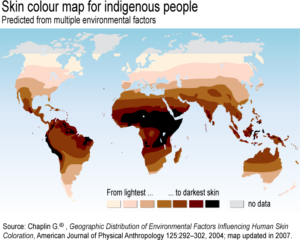
The Surprising Connections Between Disease and Longevity

The Surprising Connections Between Disease and Longevity
 While cholesterol is often regarded in a negative connotation, it actually is necessary for survival. Cholesterol is responsible for making and maintaining the cell membrane, it is an essential component of some hormone molecules, and is necessary for the production of vitamin D. In order for the body to produce vitamin D, UVB light must hit the skin and stimulate the conversion of cholesterol into vitamin D. Interestingly, UVB light also destroys folate in the skin, which is necessary for DNA replication. It is well known that humans around the globe have various skin colors, which has widely been accepted as a result of differing levels of melanin production. Individuals with darker skin evolved in climates that received a lot of strong sunlight which prompted the increased production of melanin in order to prevent the absorption of too much UVB light and protect against excessive folate degradation. Subsequently, the apolipoprotein E (ApoE4) gene is prevalent in populations with dark skin and has been linked to an increase in cholesterol. From the perspective of Dr. Moalem, this makes complete sense. Since less UVB light is able to penetrate the dark skin of these populations, the ApoE4 gene was selected for in order to increase the amount of circulating cholesterol to increase Vitamin D production. The only other population that the ApoE4 gene is largely seen in is lighter-skinned people of Northern Europe. This can be explained through a similar process. Since the Northern Europeans experience very little sunlight, even though they have light skin it is still difficult for them to produce enough vitamin D. With the ApoE4 gene they have more circulating cholesterol and therefore an increased chance of vitamin D production. This would help explain the high rate of heart disease, especially among African Americans.
While cholesterol is often regarded in a negative connotation, it actually is necessary for survival. Cholesterol is responsible for making and maintaining the cell membrane, it is an essential component of some hormone molecules, and is necessary for the production of vitamin D. In order for the body to produce vitamin D, UVB light must hit the skin and stimulate the conversion of cholesterol into vitamin D. Interestingly, UVB light also destroys folate in the skin, which is necessary for DNA replication. It is well known that humans around the globe have various skin colors, which has widely been accepted as a result of differing levels of melanin production. Individuals with darker skin evolved in climates that received a lot of strong sunlight which prompted the increased production of melanin in order to prevent the absorption of too much UVB light and protect against excessive folate degradation. Subsequently, the apolipoprotein E (ApoE4) gene is prevalent in populations with dark skin and has been linked to an increase in cholesterol. From the perspective of Dr. Moalem, this makes complete sense. Since less UVB light is able to penetrate the dark skin of these populations, the ApoE4 gene was selected for in order to increase the amount of circulating cholesterol to increase Vitamin D production. The only other population that the ApoE4 gene is largely seen in is lighter-skinned people of Northern Europe. This can be explained through a similar process. Since the Northern Europeans experience very little sunlight, even though they have light skin it is still difficult for them to produce enough vitamin D. With the ApoE4 gene they have more circulating cholesterol and therefore an increased chance of vitamin D production. This would help explain the high rate of heart disease, especially among African Americans.